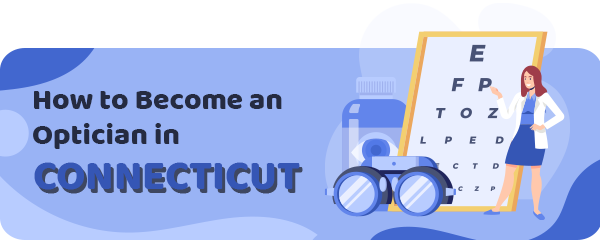The role of an optician is considered one of the more accessible positions within the medical field.
For those aspiring to become opticians in Connecticut, this article is tailored to your interests!
We have conducted thorough research on the prerequisites for this profession, as well as aspects such as salary, among other relevant details. Dive in for comprehensive insights!
Article Table of Contents
Optician Job Duties in Connecticut
Numerous individuals rely on spectacles to enhance their vision, yet each person possesses unique requirements in this regard, no pun intended.
This is where the pivotal role of an optician comes into play, as they contribute to improving people’s vision through various tasks, including:
- Deciphering and interpreting prescriptions
- Crafting eyewear
- Ensuring proper fitting and adjustments of eyewear
- Guiding on eyewear issues and maintenance
- Maintaining meticulous sales records
- Determining insurance co-pays
- Managing inventory
- Coordinating with lens manufacturing labs
While aiding clients in selecting their eyewear, opticians must also consider budget constraints and individual preferences.
It is essential to note that opticians are not authorized to conduct eye examinations or prescribe eyewear.
Optician Training in Connecticut
In the state of Connecticut, opticians are mandated to obtain a license from the Connecticut State Department of Health.
To secure a license, the Department mandates the following requirements:
- Possession of an Associate’s degree or equivalent work experience, which equates to either four years or 8,000 hours of practical experience.
- Verification of successfully passing the ABO and NCLE exams.
- Confirmation of completing the required apprenticeship.
- Verification of existing licensure, if applicable.
- A clean criminal record.
- Submission of a duly completed application.
- Provision of a recent photograph.
Securing formal education is imperative for aspiring opticians looking to obtain licensure in Connecticut.
Goodwin College 
Goodwin College’s program grants an Associate’s degree in Vision Care Technology, preparing students comprehensively for licensing exams.
The advantages that should convince you to enroll in the program offered by this college are:
- Financial aid for those who need it
- Easy process when it comes to enrollment
- The possibility of transferring credits
Middlesex Community College 
Middlesex Community College also offers an Associate’s degree program, specifically in Ophthalmic Medical Assisting.
The tuition is more budget-friendly, and most students pursue programs for around two years.
Should these two schools not align with your preferences, alternative options include enrolling in online programs or exploring colleges in different states.
Enrollment requirements may vary, but generally, applicants are expected to provide:
- High school diploma or GED
- Completion of specific classes with a minimum grade of C
- Two letters of recommendation
- OAT scores (not older than 5 years)
- Minimum GPA of 2.75
Key topics covered in optician training programs include Introduction to Optometry, Ocular Anatomy, Ophthalmic Imaging, Glaucoma, and Physics.
An additional avenue for acquiring education is through apprenticeships, which typically span a minimum of 8,000 hours.
Regrettably, the availability of schools offering specialized programs for these professionals is limited in this state, as illustrated in the table below.
| School Name | Address |
|---|---|
| Goodwin College | 1 Riverside Dr, East Hartford, CT 06118 |
| Middlesex Community College | 100 Training Hill Rd, Middletown, Connecticut 06457-4829 |
Certification or Licensure for an Optician in Colorado
After finishing your training or education, the next step is to prepare for and successfully navigate the licensing tests, which include:
- The National Opticianry Competency Examination (NOCE), administered by ABO (American Board of Opticianry)
- The Contact Lens Registry Examination (CLRE), overseen by NCLE (National Contact Lens Examiners)
These exams are available in both English and Spanish, with an approximate fee of $200 for each.
It is noteworthy that CLRE is an optional exam, and a minimum passing score of 70% is required.
Both NOCE and CLRE are structured at three proficiency levels:
- Beginner,
- Intermediate,
- Advanced.
As the pivotal exam, NOCE concentrates on spectacles and encompasses topics such as reading prescriptions, fitting and dispensing spectacles, and using standard ophthalmic equipment.
ABO organizes NOCE twice a year and provides ample preparatory materials on its website.
On the other hand, CLRE is tailored for those interested in working with contact lenses, covering aspects like:
- Pre-fitting for lenses
- Diagnostic fitting
- Dispensing of lenses
- Patient Education
- Delivery
- Follow-up
When you feel ready to undertake these exams, you must contact the nearest Prometric testing center.
Successful completion of the exams qualifies you to apply for your optician license, for which the following documents are typically required:
- Proof of identity
- High school diploma or GED
- Completed application form
- Payment of the application fee
- Clean criminal record
- Examination scores
The American Board of Opticianry requires license renewal after every 3 years.
This procedure usually involves paying the real fee and continuing your education.
Optician Salary in Connecticut
Regarding salary considerations, various factors come into play, influencing the compensation structure.
Here’s a breakdown of the aspects that can impact your earnings:
- Job title
- Location
- Job’s duties
- Management roles
- Distinctions between sales and technician roles
For specific figures, the following table outlines average salaries in the primary cities of Connecticut.
Annual Salary Range:| Location | Avg. Annual Salary |
|---|---|
| Cos Cob | $61,100 |
| Fairfield | $60,300 |
| Bridgeport | $60,300 |
| Milford | $60,300 |
| Easton | $60,300 |
| Monroe | $60,200 |
| Hawleyville | $58,900 |
| West Haven | $57,500 |
| Avon | $57,500 |
| Norwich | $56,700 |
Regional Salary in Connecticut
| Region | Employed | Avg. Annual Salary | Avg. Hourly Pay | Top 10% Annual Salary | Bottom 10% Annual Salary |
|---|---|---|---|---|---|
| Bridgeport-Stamford-Danbury, CT | 140 | $67,400 | $32.40 | $86,260 | $46,680 |
| Hartford-West Hartford-East Hartford, CT | 210 | $64,880 | $31.19 | $82,530 | $42,650 |
| New Haven, CT | 80 | $64,860 | $31.19 | $84,990 | $45,440 |
| Norwich-New London-Willimantic, CT | 60 | $66,700 | $32.07 | $81,730 | $46,800 |
| Waterbury-Shelton, CT | 70 | $65,580 | $31.53 | $84,990 | $47,770 |
* Employment conditions in your area may vary.
Frequently Asked Questions
Where can I find work as an optician in Connecticut?
If you don’t know where you can get hired, check out some locations where opticians are in demand:
- Stores
- Offices
- Optometry practices
- Hospitals
- Clinics
What are the skills needed by an optician in Connecticut?
Opticians have the following abilities:
- Attention to details
- Good communication skills
- Adaptable to new situations
- Business skills
- Physical stamina
- Ability to perform repetitive tasks
What are the skills needed by an optician in Connecticut?
Opticians have the following abilities:
- Attention to details
- Good communication skills
- Adaptable to new situations
- Business skills
- Physical stamina
- Ability to perform repetitive tasks
Read the full guide: How to Become an Optician


